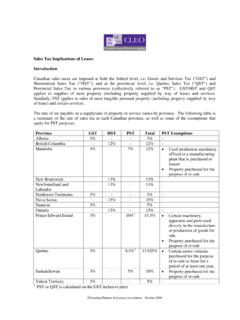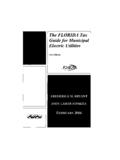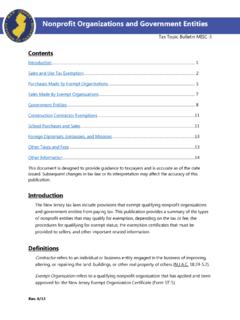Transcription of Line-Item Analysis of Earnings Quality - Columbia University
1 Foundations and TrendsR inAccountingVol. 3, Nos. 2 3 (2008) 87 221c 2009 N. D. Melumad and D. NissimDOI: Analysis of Earnings QualityBy Nahum D. Melumad and Doron NissimContents1 Introduction882 Overview of Earnings Quality913 Overview of Earnings Management964 Revenue1075 Accounts Receivable1246 Inventory1317 Property, Plant and Equipment1428 Intangible Assets1539 Investments in Debt Securities16010 Debt16411 Leases16812 Income Taxes17213 Pension and Other Post-Retirement Benefits17914 Contingencies18415 Other Liabilities18716 Derivatives19017 Investment in Equity Securities and VariableInterest Entities19518 Shareholders Equity20319 Concluding Comments213 References214 Foundations and TrendsR inAccountingVol. 3, Nos. 2 3 (2008) 87 221c 2009 N. D. Melumad and D. NissimDOI: Analysis of Earnings Quality Nahum D. Melumad1and Doron Nissim21 Columbia Business School, Columbia University , New York, NY 10027,USA, Business School, Columbia University , New York, NY 10027,USA, this paper, we discuss Earnings Quality and the related conceptof Earnings management, focusing on the primary financial each key Line-Item from the financial statements, we summarizeaccounting and economic considerations applicable to that item, dis-cuss implications for Earnings Quality , evaluate the susceptibility of theitem to manipulation, and identify potential red flags.
2 The red flags andspecific issues discussed for the individual line -items provide a frame-work for fundamental and contextual Analysis by academic researchersand practitioners.*We thank Shira Cohen, Ron Dye, Trevor Harris, Hanna Lee, Bugra Ozel, and an anony-mous referee for their helpful comments and Lev, in his influential 1989 critique of empirical research onthe usefulness of accounting Earnings , argued that the generally lowR2values in market-based tests of Earnings Quality were disconcertingand implying limited usefulness of accounting Earnings . Lev suggestedthat capital market research in accounting should shift its focus tothe examination of the role of accounting measurement rules in assetvaluation. He further suggested that a promising direction for futureresearch is to examine Earnings Quality the last 20 years, a number of studies have employed fundamen-tal and contextual analyses in an attempt to improve our understand-ing of the usefulness of Earnings and other accounting variables.
3 Twoof the earlier attempts were Bernard and Stober (1989) and Bernardand Noel (1991). Both studied the incremental usefulness of workingcapital accounts. Bernard and Stober (1989) investigated the abilityof inventory and account receivable balances to predict future and Noel (1991) examined alternative economic models of the1A similar recommendation was made by Penman (1992), who called for concentratedaccounting research aimed at studying fundamentals that is, key value-drivers suchas components of Earnings , risk, growth, and competitive cycle and their implications for using inventorydisclosures to predict future sales and future Earnings . Results weregenerally null or mixed at best. Bernard and Stober (1989) con-cluded that further progress in this line of research would require abetter understanding of the economic context in which the implicationsof detailed Earnings components are interpreted.
4 They also suggestedthat any research based on short-run association tests would requirebetter knowledge of the process by which information is transmittedfrom firms to the notable attempt at fundamental Analysis was made by Levand Thiagarajan (1993). Lev and Thiagarajan identified a set of finan-cial variables (fundamentals) claimed by analysts to be useful in secu-rity valuation and examined these claims by estimating the incrementalvalue-relevance of these variables over Earnings . Their findings supportthe incremental value-relevance of most of the identified , looking at data from the 1980s, fundamentals added about 70%to the explanatory power of Earnings with respect to excess returns. Afollow-up on this study by Abarbanell and Bushee (1997) found some-what weaker results. Specifically, the associations between the individ-ual signals and future Earnings changes were insignificant for many ofthe fundamental signals identified by Lev and Thiagarajan.
5 Lev andZarowin (1999) reexamined the usefulness of reported Earnings andother financial variables and found that it has deteriorated during theperiod 1977 to 1996. They attributed the deterioration to the increasein the level of change experienced by companies during the the fundamental Analysis literature over the last twodecades, many of the results are either null or mixed. As suggestedby many researchers, including the above authors, fundamental anal-yses are difficult because the relation between Earnings and returns istoo highly contextual to model parsimoniously. One grim speculationarticulated by Bernard and Stober was that, it is possible that thelinks between detailed Earnings components and valuation are so highlycontextual that no parsimonious model would ever capture more than2 Another possible explanation might be an increase in Earnings management and manipu-lation during that period as management rewards for improved financial performance small portion of the story (1989, p.)
6 648). With the benefit of thelast 20 years of fundamental Analysis research, Bernard and Stober scautionary note seems even more profound this paper, we present a comprehensive summary and analy-sis of the specific Earnings Quality issues pertaining to key line -itemcomponents of the financial statements. After providing an overviewof Earnings Quality (Section 2) and Earnings management (Section 3),we turn to the Analysis of the key line -items from the financial state-ments (Section 4 through Section 18). For each key Line-Item , we reviewaccounting principles, discuss implications for Earnings Quality , evalu-ate the susceptibility of the item to manipulation, and describe analysesand red flags which may inform on the item s Quality . We hope that ouranalysis and evaluations will prove useful in conducting fundamentaland contextual of Earnings QualityAccording to Statement of Financial Concepts (SFAC) No.
7 1, read-ers of financial statements use reported Earnings in various ways,includingto help them(a)evaluate management s performance,(b)estimate Earnings power or other amounts theyperceive as representative of long-term earning abil-ity of an enterprise,(c)predict future Earnings , or(d)assess the risk of investing in or lending to an enter-prise. (para. 47)Arguably, this statement regarding how investors use reportedearnings implies how one should evaluate Earnings Quality forexample, Earnings are of high Quality if they are representative oflong-term earning ability. Yet this statement suggests diverse uses ofearnings information and, accordingly, alternative definitions of earn-ings Quality . Indeed, there seems to be no consensus in the aca-demic and professional literatures on how to define Earnings following alternative definitions have been employed by different9192 Overview of Earnings Qualityresearchers:Conservatism The Quality of conservatively determined Earnings ishigh because they are less likely to prove overstated in the light offuture Earnings Earnings are of high Quality when they accu-rately reflect the change in net asset value due to earning (sustainability) Earnings are of high Quality when theyare expected to recur, that is, when the current level of Earnings isa good proxy for the expected level of Earnings in future years.
8 Thisdefinition does not preclude Earnings from being volatile over- time ,but it does imply that such volatility should be related to changes inexpected future High Quality Earnings exhibit low volatility High Quality Earnings are to cash flows High- Quality Earnings include relatively smallaccruals ( , Sloan, 1996) or have accruals which are strongly relatedto past, current or future cash flows ( , Dechow and Dichev, 2002).While some of these views are related, they are generally quitedistinct from one another and often have contradictory example, fair value accounting that is, measuring assets andliabilities at fair value with unrecognized gains and losses included inincome may improve the accuracy of Earnings as a measure of changein value, but is likely to reduce the persistence and predictability ofearnings. As another example, when managers smooth Earnings over- time a widespread form of Earnings management they increasethe persistence and predictability of Earnings but weaken the relation-ship between Earnings and cash flows, since Earnings management isoften conducted through the management of theoretical work on Earnings Quality has interpreted earningsquality as the precision of an accounting signal with respect to afundamental ( , Dye, 1990; Penno, 1996; Jorgensen and Kirschen-heiter, 2003; Dye and Sridhar, 2007), or defined high- Quality earn-ings as Earnings that are relatively permanent ( , Sankar and93 Subramanyam, 2001; Kirschenheiter and Melumad, 2008).
9 Empiricalresearch has focused on the sustainability view of Earnings Quality ,and investigated the information in various accounting quantitiesand ratios regarding future Earnings changes. For example, studieshave examined future Earnings implications of various measures ofaccruals and cash flow ( , Sloan, 1996; Dechow and Dichev, 2002;Xie, 2001; Lev and Nissim, 2006), financial statement decomposition( , Fairfield et al., 1996; Abarbanell and Bushee, 1997; Nissim andPenman, 2001, 2003; Penman et al., 2007) conservatism distortions( , Lev and Sougiannis, 1996; Penman and Zhang, 2002), and taxand pension disclosures ( , Amir and Benartzi, 1998; Shevlin, 2002;Lev and Nissim, 2004).Similar to academics, practitioners appear to equate earning qual-ity with Earnings persistence or sustainability. This is due in part tothe extensive use of multiple-based valuation, where equity value isestimated by applying a multiple to some measure of Earnings ( ,EPS or EBITDA).
10 A primary determinant of Earnings multiples is theperceived persistence of Earnings the higher the persistence, thelarger the multiple. Relatedly, higher Earnings persistence implies thatmultiple-based valuation is likely to yield precise valuations becausecurrent Earnings are a good predictor of future Earnings and hencea good indicator of intrinsic , to the extent that highearnings persistence reduces uncertainty and helps mitigate informationasymmetries between insiders and investors, we may see a reduction inthe cost of capital and a further increase in the multiple. We, there-fore, adopt the persistence view of Earnings Quality and use it as theprimary benchmark when evaluating the impact of accounting choicesand methods on Earnings we focus on the persistence of reported Earnings , we also eval-uate the impact of accounting choices which do not change bottom-lineincome but rather affect other financial disclosures.















